Crater Lake Weather offers a unique experience for visitors to the Crater Lake National Park in Oregon. This comprehensive guide covers trip planning, a range of activities, camping options, and essential information about the national park and its weather conditions. From exploring the mesmerizing lake views to engaging in outdoor adventures, such as hiking and snow activities, Crater Lake has something for everyone. Whether you are interested in sunny summers or snowy winters, this guide will help you plan your visit accordingly.
Key Takeaways:
- Crater Lake Weather offers a unique experience with its diverse climate and weather conditions.
- Plan your trip to Crater Lake National Park based on your preferred activities and the time of year.
- Be prepared for possible fluctuations in temperature, wind, humidity, and visibility during your visit.
- Explore key attractions such as overlooks, waterfalls, and visitor centers to fully appreciate the natural beauty of Crater Lake.
- Engage in various activities like hiking, snowshoeing, and skiing to make the most of your visit to Crater Lake National Park.
Crater Lake Weather Conditions: Temperature, Wind, Humidity, and Visibility
When planning a visit to Crater Lake National Park, it’s essential to understand the weather conditions you might encounter during your trip. Crater Lake’s weather can be variable and is influenced by the time of year and elevation. From temperature fluctuations to wind patterns, humidity levels, and visibility, being prepared for these conditions will help you make the most of your experience at this breathtaking destination.
One of the key factors to consider is the temperature. Summers at Crater Lake are short and sunny, with warm temperatures at lower elevations and cooler temperatures around the lake’s rim. July, August, and September are the best months for warm and dry weather. On the other hand, winters are long and snowy, with average snowfall of 41 feet at park headquarters. It’s crucial to layer clothing and pack accordingly to stay comfortable in changing temperatures.
Wind is another important aspect of Crater Lake’s weather. The park is known for its gusty conditions, especially during the winter months. Be prepared for strong winds, particularly at higher elevations and exposed areas, which can affect outdoor activities and make the temperature feel colder. Additionally, it’s important to consider the wind when planning boat tours or other water-based activities on the lake.
Humidity and visibility are also significant factors to consider. Humidity levels can vary, but in general, Crater Lake experiences low humidity due to its high elevation and the surrounding dry climate. This dryness can contribute to increased evaporation rates on the lake’s surface. Visibility can be excellent, providing stunning panoramas of the lake and surrounding landscapes. However, weather conditions, such as fog or wildfire smoke, can occasionally impact visibility, so it’s advisable to check the forecast and be prepared for potential changes during your visit.
| Weather Condition | Temperature | Wind | Humidity | Visibility |
|---|---|---|---|---|
| Summer | Varies by elevation | Moderate | Low | Excellent |
| Winter | Cool to cold | Strong | Low | Varies (potentially reduced by fog or smoke) |
As always, it’s important to check the weather forecast before your visit to Crater Lake National Park. This will help you plan your activities accordingly and ensure you have appropriate clothing and gear. Being prepared for the weather conditions will allow you to fully enjoy the natural beauty and recreational opportunities that Crater Lake has to offer.
Key Attractions: Overlooks, Waterfalls, and Visitor Centers
Crater Lake National Park is home to a variety of key attractions that captivate visitors with their natural beauty and awe-inspiring vistas. From the park’s numerous overlooks to its stunning waterfalls and informative visitor centers, there is no shortage of remarkable sights to explore.
Overlooks
The park boasts 32 overlooks strategically positioned to offer breathtaking views of Crater Lake and its surrounding landscapes. These overlooks provide visitors with the perfect vantage points to marvel at the lake’s deep blue hues and the rugged splendor of the caldera. Each overlook offers a unique perspective, showcasing different angles and perspectives of the mesmerizing natural wonder.
Waterfalls
Crater Lake National Park is also home to two magnificent waterfalls: Vidae Falls and Plaikni Falls. Vidae Falls, located near Rim Village, cascades down a rocky cliffside, creating a picturesque spectacle for visitors. Plaikni Falls, on the other hand, provides a more secluded and serene experience, nestled within a lush forested area. These waterfalls offer tranquil spots for visitors to relax, take in the beauty of their surroundings, and capture stunning photographs.
Visitor Centers
To enhance visitors’ understanding and appreciation of the park, Crater Lake offers two visitor centers: the Steel Information Center and the Rim Visitor Center. The Steel Information Center, located south of the lake, is open year-round and serves as a valuable resource for park information, exhibits, and educational materials. The Rim Visitor Center, open from June to September, offers interactive displays, ranger-led programs, and stunning panoramic views of the lake. These visitor centers are excellent starting points for exploring the park, providing insights into its geology, history, and cultural significance.
Whether marveling at the breathtaking views from the park’s overlooks, hiking to picturesque waterfalls, or delving into the park’s rich history at its visitor centers, Crater Lake’s key attractions offer a vibrant and immersive experience for visitors seeking to connect with nature and explore one of America’s most awe-inspiring national parks.
Activities and Things to Do: Hiking, Snowshoeing, Skiing, and More
When it comes to activities and things to do at Crater Lake National Park, visitors are spoiled for choice. Whether you prefer exploring on foot, gliding through snowy landscapes, or taking in the breathtaking views, there is something for everyone. Here are some of the top activities to consider during your visit:
Hiking
Crater Lake offers a variety of hiking trails that cater to all experience levels. From leisurely strolls along the rim to challenging treks that lead to panoramic vistas, hikers can immerse themselves in the park’s natural beauty and geological wonders. Don’t forget to pack sturdy footwear, water, and sunscreen for a comfortable and enjoyable hike.
Snowshoeing
During the winter months, Crater Lake transforms into a winter wonderland, providing the perfect opportunity for snowshoeing. Strap on a pair of snowshoes and explore the park’s trails at your own pace. Guided snowshoe hikes are also available, allowing you to learn about the park’s history and wildlife while admiring the snowy landscapes.
Skiing
If you’re a skiing enthusiast, Crater Lake offers excellent opportunities for cross-country skiing. Glide through the pristine snow-covered terrain and take in the serene beauty of the park. Whether you’re a beginner or an experienced skier, the park’s winter trails cater to all skill levels.
Other activities at Crater Lake include boat tours, fishing, photography, and wildlife watching. No matter what you choose, be sure to embrace the natural wonders of Crater Lake and create unforgettable memories.
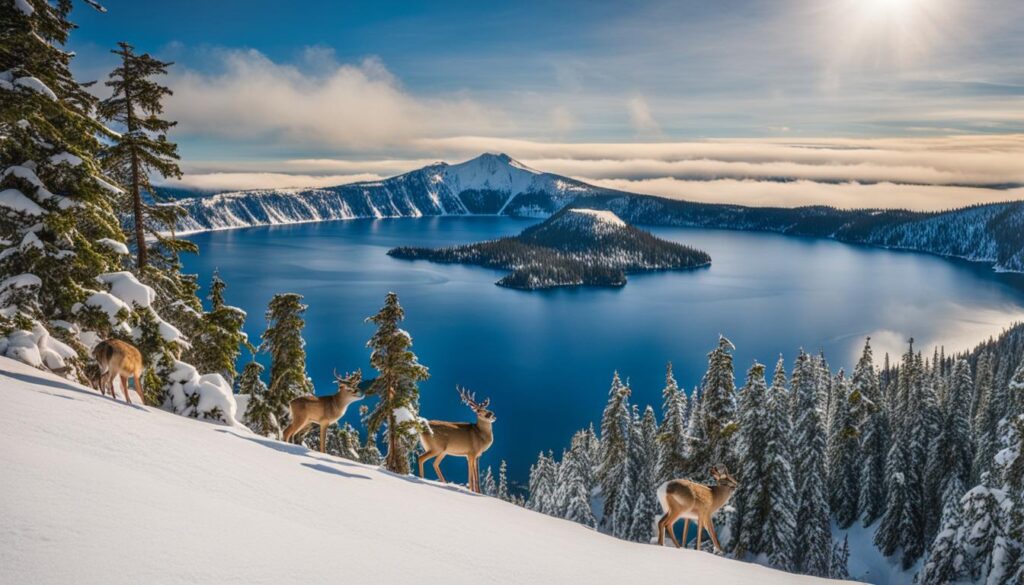
| Activity | Description |
|---|---|
| Hiking | Explore the park’s hiking trails and immerse yourself in the natural beauty and geological wonders of Crater Lake. |
| Snowshoeing | Strap on a pair of snowshoes and venture out into the snowy landscapes of Crater Lake during the winter months. |
| Skiing | Enjoy cross-country skiing on the park’s winter trails and experience the serene beauty of Crater Lake. |
| Boat Tours | Take a boat tour and explore the crystal-clear waters of Crater Lake, marveling at the unique geological formations. |
| Fishing | Cast your line and try your luck at fishing in Crater Lake, home to a variety of fish species. |
| Photography | Capture the stunning landscapes and breathtaking views of Crater Lake through photography. |
| Wildlife Watching | Observe the diverse wildlife that inhabits Crater Lake National Park, including birds, mammals, and more. |
Best Times to Visit: Summer vs Winter, Wildflowers, and Photography
When planning your visit to Crater Lake National Park, it’s important to consider the best time to experience its unique beauty and engage in your desired activities. The park offers distinct seasons, each with its own charms and opportunities. Whether you prefer the vibrant summers or the tranquil winters, there is a time that will best suit your preferences.
Summer Visits:
Summers at Crater Lake are characterized by warm and dry weather, making it an ideal time for outdoor activities and exploration. From July through September, the park experiences its peak season, with longer days and comfortable temperatures for hiking, wildlife viewing, and boat tours. The clear skies during this time provide excellent visibility of the stunning blue lake, allowing for breathtaking photographs.
Winter Visits:
Winter transforms Crater Lake into an enchanting wonderland, blanketing the park in a layer of pristine snow. From November to April, you can experience the serene beauty of the snow-covered landscape. Winter visits offer unique opportunities for snowshoeing, skiing, and snowboarding. The park’s trails become a winter playground, inviting visitors to explore the glistening forests and frozen waterfalls. Capture the ethereal beauty of the snow and ice with your photography skills.
Witness Wildflowers:
For those who appreciate the delicate beauty of wildflowers, the months of May, June, and October are worth considering. As the snow melts in lower elevations, vibrant wildflowers bloom, adding splashes of color to the landscape. These transitional seasons offer a quieter experience, providing the chance to witness the park’s natural cycle of growth and renewal. Don’t forget to bring your camera to capture the stunning wildflower displays.
Photography:
Photography enthusiasts will find inspiration at Crater Lake throughout the year. The park’s breathtaking vistas, changing weather conditions, and mesmerizing landscapes offer endless opportunities to capture stunning images. Whether you’re capturing the vibrant colors of summer, the contrast of snow against the deep blue lake in winter, or the delicate details of wildflowers in bloom, Crater Lake is a paradise for photographers of all skill levels.
Plan your visit to Crater Lake considering your preferred season, desired activities, and photographic opportunities. Each time of year has its own unique wonders waiting to be explored and captured. Remember to check the park’s official website for updated information on weather conditions, road closures, and visitor guidelines to ensure a smooth and enjoyable visit to this natural wonder.
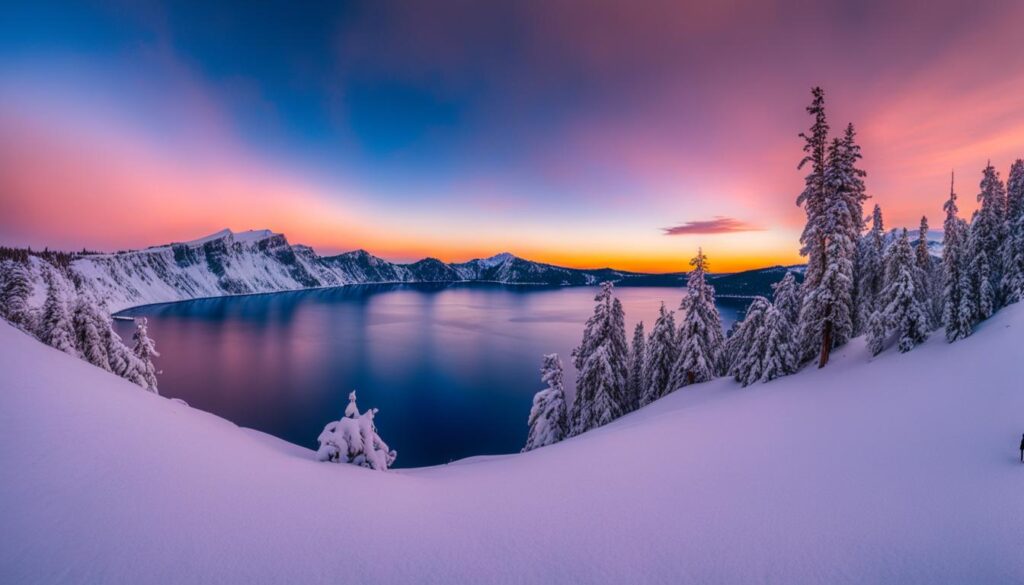
Hours and Operations: Park Hours, Seasons, and Road Closures
When planning your visit to Crater Lake National Park, it’s important to be aware of the park’s hours of operation, the different seasons, and any potential road closures. Understanding these factors will help you make the most of your trip and ensure a smooth and enjoyable experience.
Park Hours
The park’s hours vary depending on the season. During the summer months, the park is typically open from 7:00 am to 10:00 pm, allowing visitors ample time to explore the various attractions and engage in outdoor activities. However, it’s essential to check the park’s official website or contact them directly for the most up-to-date information on operating hours, as they may be subject to change.
Seasons
Crater Lake experiences four distinct seasons throughout the year. Summers are generally warm and dry, making it an ideal time for outdoor activities such as hiking and boating. Fall brings picturesque foliage and milder temperatures, providing a serene and colorful backdrop for exploration. Winters are snowy and can be quite cold, creating unique opportunities for winter sports like snowshoeing and skiing. Finally, spring offers stunning wildflowers and the melting of the winter snow, showcasing the park’s natural beauty in transition.
Road Closures
During certain times of the year, Crater Lake National Park may experience road closures due to snowfall and hazardous conditions. The park is known for its significant snowfall, with an average of 41 feet at park headquarters. It’s important to stay informed about any road closures or changes in accessibility, especially if you plan to visit during the winter months. Checking the park’s website or contacting them directly will provide you with the most up-to-date information.
| Season | Park Hours | Road Closures |
|---|---|---|
| Summer | 7:00 am to 10:00 pm | No road closures |
| Fall | Varies | No road closures |
| Winter | Varies | Potential road closures due to snow |
| Spring | Varies | No road closures |
By familiarizing yourself with the park’s hours of operation, the different seasons, and any road closures, you can plan your visit to Crater Lake National Park more effectively. Whether you’re exploring the park’s stunning viewpoints, engaging in outdoor activities, or simply enjoying the serene beauty of the lake, being prepared will ensure a memorable experience.
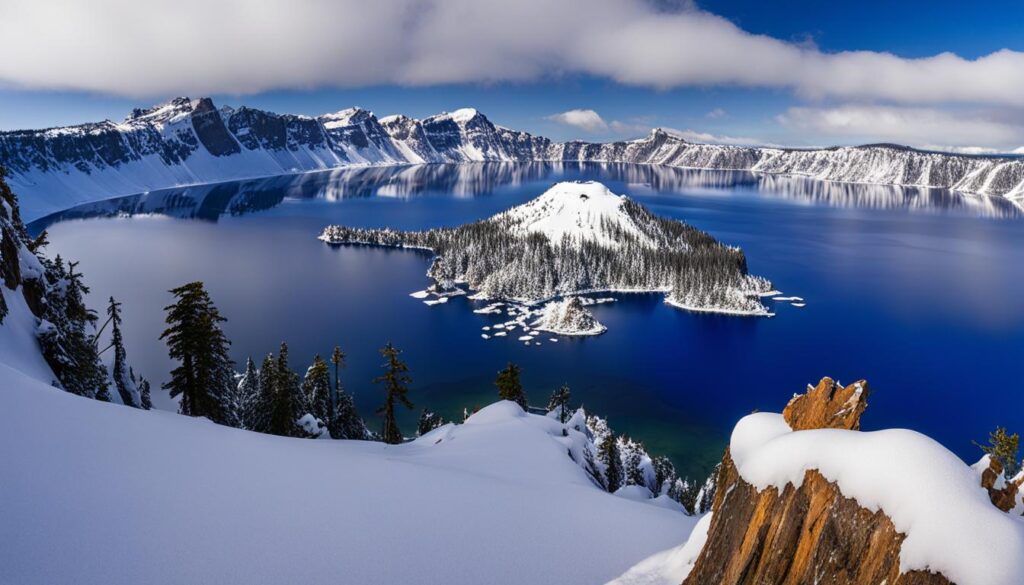
RV Parks and Camping at Crater Lake
Crater Lake National Park offers a range of RV parks and camping options for visitors who want to immerse themselves in the park’s natural surroundings. Whether you prefer the convenience of an RV or the simplicity of tent camping, there are options available to suit your needs.
The Mazama Campground is a popular choice for both tent and RV campers. This campground offers a variety of amenities, including restrooms, fire pits, picnic tables, and access to potable water. It is located in a beautiful forested area near the park entrance, providing a peaceful and serene camping experience. Reservations are strongly recommended, especially during peak season.
For those seeking a more rustic camping experience, the Lost Creek Campground is a great option. This campground offers tent camping only and is situated in a picturesque meadow. While it lacks some of the amenities of the Mazama Campground, it provides a unique opportunity to truly connect with nature. It operates on a first-come, first-served basis, so arrive early to secure a spot.
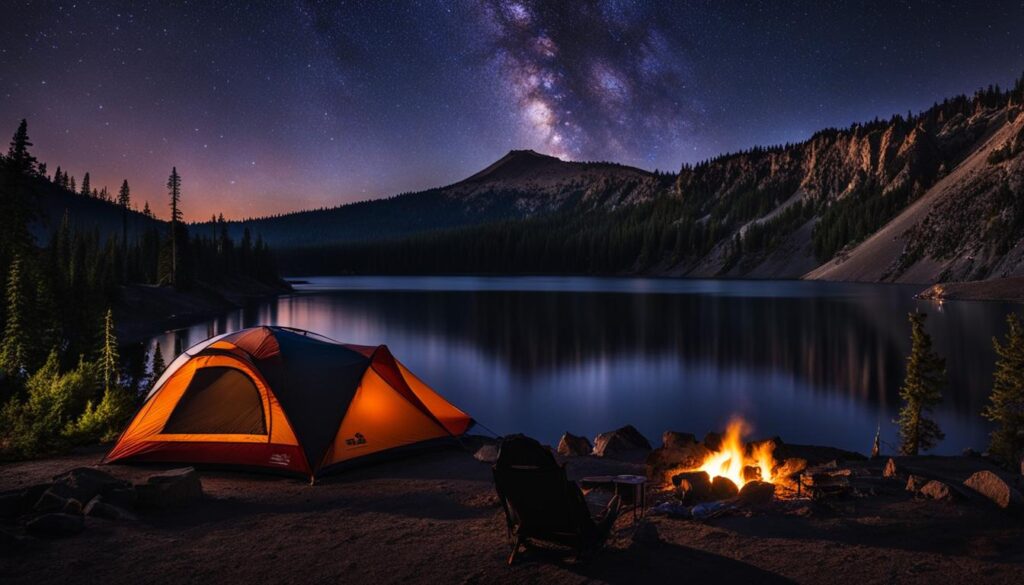
Camping Options at Crater Lake National Park
Table: Comparison of Mazama Campground and Lost Creek Campground
| Mazama Campground | Lost Creek Campground | |
|---|---|---|
| Location | Near the park entrance | In a picturesque meadow |
| Amenities | Restrooms, fire pits, picnic tables | No amenities, rustic camping |
| Availability | Reservations recommended | First-come, first-served |
| Tent Camping | Yes | Yes |
| RV Camping | Yes | No |
When planning your visit to Crater Lake, make sure to consider your camping preferences and book your campsite or RV spot in advance. Both the Mazama and Lost Creek campgrounds offer unique experiences, allowing you to fully enjoy the natural beauty of Crater Lake National Park.
Hotels, Campsites, and Cabins: Where to Stay Near Crater Lake
When planning a visit to Crater Lake, it’s important to consider your accommodation options to enhance your overall experience. Whether you prefer the convenience of a hotel, the tranquility of a campsite, or the rustic charm of a cabin, there are various choices available near the national park.
If you’re looking for comfortable lodging within the park itself, there are hotels and lodges that provide easy access to Crater Lake’s attractions. These accommodations offer a range of amenities and services, ensuring a comfortable stay for visitors. From cozy rooms with stunning views to on-site dining options, you can enjoy the beauty of the park while enjoying the comforts of a hotel.
For those who want to immerse themselves in the natural surroundings, there are campsites available near Crater Lake. These campsites offer a unique experience of staying close to nature while enjoying the park’s beauty. Camping options range from developed campsites with facilities like restrooms and fire pits to more rustic and secluded sites for a true wilderness experience.
If you’re seeking a blend of nature and comfort, cabins near Crater Lake provide a cozy retreat. These cabins offer a rustic atmosphere and are equipped with amenities like kitchens, bathrooms, and heating, ensuring a comfortable stay throughout your visit. Wake up to the peaceful sounds of nature and enjoy the serenity of the park from the comfort of your own cabin.
Table: Accommodation Options Near Crater Lake
| Accommodation Type | Description |
|---|---|
| Hotels and Lodges | Convenient accommodations within the park with amenities and services. |
| Campsites | Nearby campsites for a close-to-nature experience. |
| Cabins | Rustic retreats with a blend of nature and comfort. |
Whatever accommodation option you choose, it’s recommended to make reservations in advance, especially during peak season, to secure your preferred choice. Whether you’re looking for a luxurious hotel, a peaceful campsite, or a cozy cabin, there’s an option to suit your preferences and budget near Crater Lake.
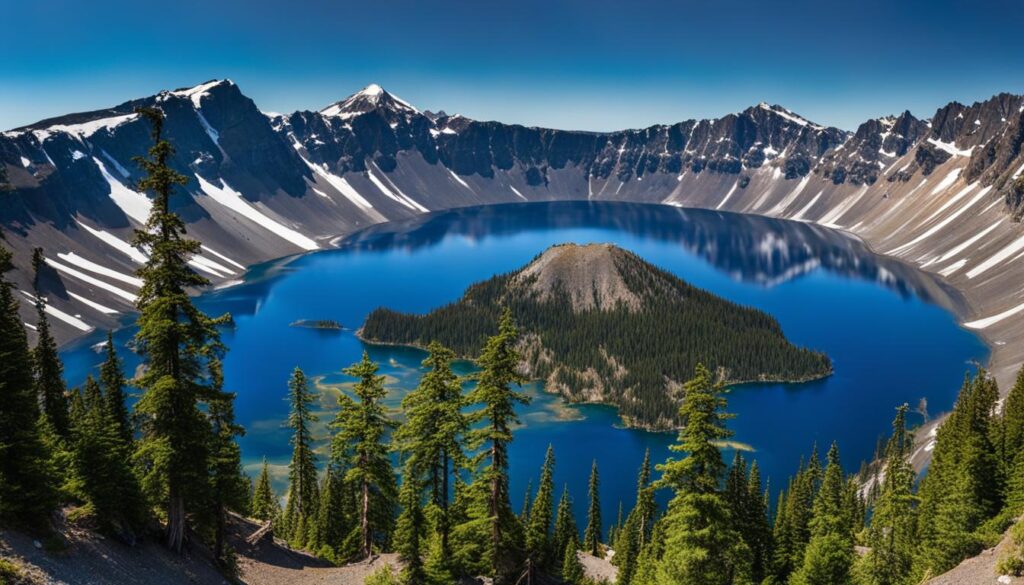
Conclusion: Plan Your Visit to Experience Crater Lake Weather
Crater Lake National Park is a remarkable destination that offers a stunning natural landscape and diverse recreational opportunities. Whether you’re planning a weekend getaway or a longer vacation, exploring the weather at Crater Lake is an essential part of your trip. By understanding the unique weather conditions, you can make the most of your visit and create unforgettable memories.
To plan your visit effectively, use this comprehensive Crater Lake weather guide as your go-to resource. It provides all the information you need to know about the temperature, wind, humidity, and visibility conditions that you may encounter during your trip.
Additionally, this guide serves as a valuable Crater Lake National Park guide. It covers key attractions, activities and things to do, the best times to visit, hours and operations, and various accommodation options. With this knowledge in hand, you can tailor your itinerary to your interests and preferences, ensuring a fulfilling and enjoyable experience at Crater Lake.
So, whether you’re a nature lover, outdoor enthusiast, or simply seeking a memorable adventure, plan your visit to Crater Lake National Park and immerse yourself in the wonders of its extraordinary weather and natural splendor. Start exploring the Crater Lake weather guide and create an itinerary that will make your trip an unforgettable one.
FAQ
What is the weather like at Crater Lake National Park?
The weather at Crater Lake can vary depending on the time of year and elevation. Summers are short and sunny, with warm temperatures at lower elevations and cooler temperatures around the lake’s rim. Winters are long and snowy, with an average snowfall of 41 feet at park headquarters. It’s important to check the weather forecast before your visit, as conditions can change rapidly.
What are the key attractions at Crater Lake National Park?
Crater Lake offers 32 overlooks that provide breathtaking views of the lake and surrounding landscapes. Visitors can also explore two stunning waterfalls and visit the park’s visitor centers to learn more about its history and natural features. The Steel Information Center, located south of the lake, is open year-round, while the Rim Visitor Center is open from June to September.
What activities are available at Crater Lake?
Crater Lake offers a range of activities such as hiking, snowshoeing, skiing, boat tours, fishing, photography, and wildlife watching. Visitors can explore the park’s trails, join guided snowshoe hikes in winter, or participate in outdoor adventures throughout the year.
When is the best time to visit Crater Lake?
The best time to visit Crater Lake depends on your preferences and interests. Summers, specifically July through September, offer warm and dry weather ideal for hiking and wildlife viewing. Winter visits, from November to April, provide a unique experience with snowy landscapes and opportunities for snow activities. May, June, and October offer quieter experiences with blooming wildflowers and melting snow.
What are the park’s hours and operations?
The park’s hours vary depending on the season, and some facilities may have limited availability during certain times. It’s important to check the park’s official website or contact the park directly for up-to-date information on operating hours. Additionally, the park may experience seasonal road closures, especially during winter when snowfall and hazardous conditions can affect accessibility.
What camping options are available at Crater Lake?
Crater Lake offers RV parks and camping options, including the popular Mazama Campground and Lost Creek Campground. Both campgrounds have specific fees and regulations, and reservations are advisable, especially during peak season. Enjoy the beauty of Crater Lake by spending a night under the stars and immersing yourself in the tranquility of the park.
Where can I stay near Crater Lake?
There are hotels, campsites, and cabins located within the park, providing convenient access to its attractions. Nearby communities also offer accommodations, including hotels, cabins, and campsites, for those looking for alternative lodging options. Book in advance, especially during peak season, to secure your preferred accommodation.
How can I plan my visit to experience Crater Lake weather?
To plan your visit, consider the best time to visit based on your desired activities and weather preferences. Check the park’s hours and operations for any changes or road closures. Choose between camping or staying at nearby accommodations. Crater Lake is a must-see destination for nature lovers and outdoor enthusiasts. Immerse yourself in the wonders of this extraordinary national park and experience the marvel of Crater Lake weather on your next trip.

